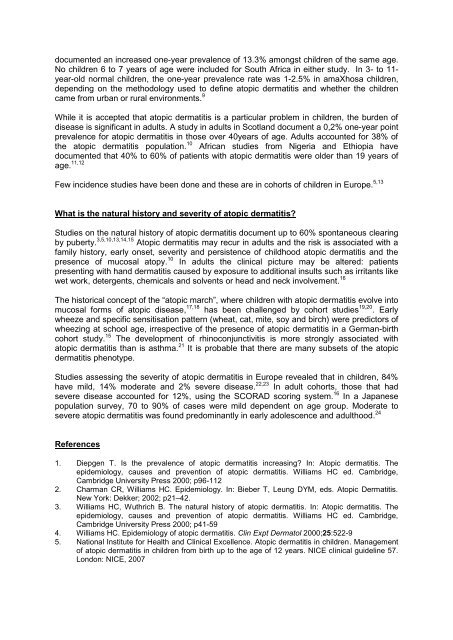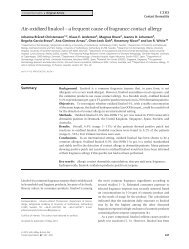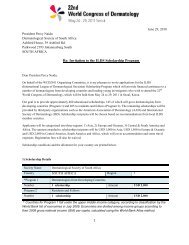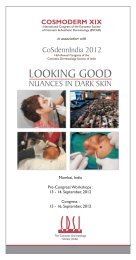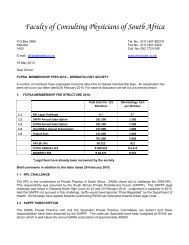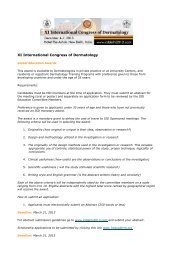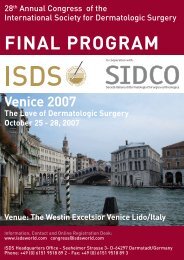Guidelines on the Management of Atopic Dermatitis ... - Dermatology
Guidelines on the Management of Atopic Dermatitis ... - Dermatology
Guidelines on the Management of Atopic Dermatitis ... - Dermatology
Create successful ePaper yourself
Turn your PDF publications into a flip-book with our unique Google optimized e-Paper software.
documented an increased <strong>on</strong>e-year prevalence <strong>of</strong> 13.3% am<strong>on</strong>gst children <strong>of</strong> <strong>the</strong> same age.<br />
No children 6 to 7 years <strong>of</strong> age were included for South Africa in ei<strong>the</strong>r study. In 3- to 11-<br />
year-old normal children, <strong>the</strong> <strong>on</strong>e-year prevalence rate was 1-2.5% in amaXhosa children,<br />
depending <strong>on</strong> <strong>the</strong> methodology used to define atopic dermatitis and whe<strong>the</strong>r <strong>the</strong> children<br />
came from urban or rural envir<strong>on</strong>ments. 9<br />
While it is accepted that atopic dermatitis is a particular problem in children, <strong>the</strong> burden <strong>of</strong><br />
disease is significant in adults. A study in adults in Scotland document a 0,2% <strong>on</strong>e-year point<br />
prevalence for atopic dermatitis in those over 40years <strong>of</strong> age. Adults accounted for 38% <strong>of</strong><br />
<strong>the</strong> atopic dermatitis populati<strong>on</strong>. 10 African studies from Nigeria and Ethiopia have<br />
documented that 40% to 60% <strong>of</strong> patients with atopic dermatitis were older than 19 years <strong>of</strong><br />
age. 11,12<br />
Few incidence studies have been d<strong>on</strong>e and <strong>the</strong>se are in cohorts <strong>of</strong> children in Europe. 5,13<br />
What is <strong>the</strong> natural history and severity <strong>of</strong> atopic dermatitis?<br />
Studies <strong>on</strong> <strong>the</strong> natural history <strong>of</strong> atopic dermatitis document up to 60% sp<strong>on</strong>taneous clearing<br />
by puberty. 3,5,10,13,14,15 <strong>Atopic</strong> dermatitis may recur in adults and <strong>the</strong> risk is associated with a<br />
family history, early <strong>on</strong>set, severity and persistence <strong>of</strong> childhood atopic dermatitis and <strong>the</strong><br />
presence <strong>of</strong> mucosal atopy. 10 In adults <strong>the</strong> clinical picture may be altered: patients<br />
presenting with hand dermatitis caused by exposure to additi<strong>on</strong>al insults such as irritants like<br />
wet work, detergents, chemicals and solvents or head and neck involvement. 16<br />
The historical c<strong>on</strong>cept <strong>of</strong> <strong>the</strong> “atopic march”, where children with atopic dermatitis evolve into<br />
mucosal forms <strong>of</strong> atopic disease, 17,18 has been challenged by cohort studies 19,20 . Early<br />
wheeze and specific sensitisati<strong>on</strong> pattern (wheat, cat, mite, soy and birch) were predictors <strong>of</strong><br />
wheezing at school age, irrespective <strong>of</strong> <strong>the</strong> presence <strong>of</strong> atopic dermatitis in a German-birth<br />
cohort study. 15 The development <strong>of</strong> rhinoc<strong>on</strong>junctivitis is more str<strong>on</strong>gly associated with<br />
atopic dermatitis than is asthma. 21 It is probable that <strong>the</strong>re are many subsets <strong>of</strong> <strong>the</strong> atopic<br />
dermatitis phenotype.<br />
Studies assessing <strong>the</strong> severity <strong>of</strong> atopic dermatitis in Europe revealed that in children, 84%<br />
have mild, 14% moderate and 2% severe disease. 22,23 In adult cohorts, those that had<br />
severe disease accounted for 12%, using <strong>the</strong> SCORAD scoring system. 16 In a Japanese<br />
populati<strong>on</strong> survey, 70 to 90% <strong>of</strong> cases were mild dependent <strong>on</strong> age group. Moderate to<br />
severe atopic dermatitis was found predominantly in early adolescence and adulthood. 24<br />
References<br />
1. Diepgen T. Is <strong>the</strong> prevalence <strong>of</strong> atopic dermatitis increasing? In: <strong>Atopic</strong> dermatitis. The<br />
epidemiology, causes and preventi<strong>on</strong> <strong>of</strong> atopic dermatitis. Williams HC ed. Cambridge,<br />
Cambridge University Press 2000; p96-112<br />
2. Charman CR, Williams HC. Epidemiology. In: Bieber T, Leung DYM, eds. <strong>Atopic</strong> <strong>Dermatitis</strong>.<br />
New York: Dekker; 2002; p21–42.<br />
3. Williams HC, Wuthrich B. The natural history <strong>of</strong> atopic dermatitis. In: <strong>Atopic</strong> dermatitis. The<br />
epidemiology, causes and preventi<strong>on</strong> <strong>of</strong> atopic dermatitis. Williams HC ed. Cambridge,<br />
Cambridge University Press 2000; p41-59<br />
4. Williams HC. Epidemiology <strong>of</strong> atopic dermatitis. Clin Expt Dermatol 2000;25:522-9<br />
5. Nati<strong>on</strong>al Institute for Health and Clinical Excellence. <strong>Atopic</strong> dermatitis in children. <strong>Management</strong><br />
<strong>of</strong> atopic dermatitis in children from birth up to <strong>the</strong> age <strong>of</strong> 12 years. NICE clinical guideline 57.<br />
L<strong>on</strong>d<strong>on</strong>: NICE, 2007


